News
Unveiling Identity Theft Statistics: How Safe Is Your Digital Identity?
These are the latest identity theft and fraud statistics in 2025
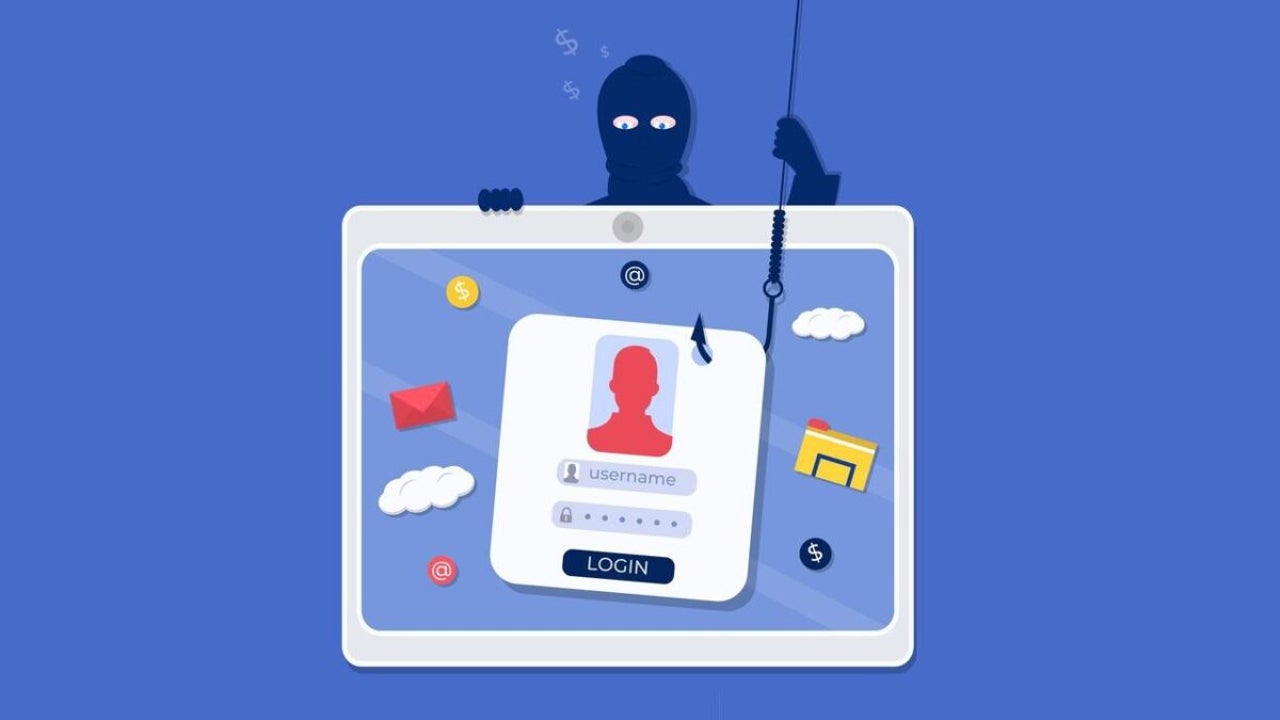
- February 1, 2025
- Updated: February 1, 2025 at 10:18 AM
Identity theft online cases are growing worldwide, raising questions and concerns about digital security. With the pandemic boosting this treacherous activity, internet users are prone to fall into the hands of cybercriminals if they are not regularly monitoring their credit reports.
With identity fraud being more accessible than ever, being proactive is the key for safety online but… Who are the victims and which are the risk factors of identity theft?
In today’s article we’ll cover this and much more while delving deep into the latest identity theft and statistics of 2025.

Subscribe to the Softonic newsletter and get the latest in tech, gaming, entertainment and deals right in your inbox.
Subscribe (it's FREE) ►Identity Theft & Online Fraud Statistics: Top Picks
- 33% of Americans have been a victim of identity theft.
- Someone has their identity stolen every 4 seconds in the US.
- Through the first three quarters of 2024, 841,810 cases of identity theft were reported in the US.
- Credit card fraud was the most common type of identity theft in 2024.
- Almost 300,000 Americans fall victim to some sort of online fraud (phishing/spoofing) every year.
- Americans aged from 30 to 39 years old are more likely to fall victim to identity theft.
- 87% of people leave personal information online.
How Frequent is Identity Theft & Fraud?
Identity theft is much more frequent than we believe. In fact, in the United States, someone has their identity stolen every 4 seconds and 60% of the victims don’t know about it until 3 or more months after it occurs. Proofpoint supports this data, stating that around 1 in 3 Americans have experienced some sort of identity theft, more than twice the global average. This leads to the alarming data gathered by the FTC, where 841,810 cases of identity theft were recorded only during the first three quarters of 2024.
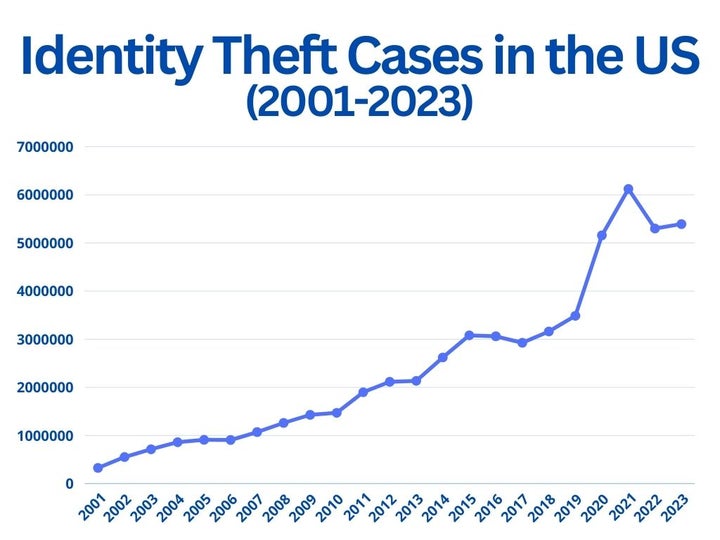
Here’s the evolution of identity theft cases since 2001 by the number of reports:
- 2001: 325,519 reports.
- 2002: 551,622 reports.
- 2003: 713,657 reports.
- 2004: 860,383 reports.
- 2005: 909,314 reports.
- 2006: 906,129 reports.
- 2007: 1,070,447 reports.
- 2008: 1,261,124 reports.
- 2009: 1,428,977 reports.
- 2010: 1,470,306 reports.
- 2011: 1,898,543 reports.
- 2012: 2,115,079 reports.
- 2013: 2,134,565 reports.
- 2014: 2,620,931 reports.
- 2015: 3,080,378 reports.
- 2016: 3,060,824 reports.
- 2017: 2,926,167 reports.
- 2018: 3,161,213 reports.
- 2019: 3,485,938 reports.
- 2020: 5,156,880 reports.
- 2021: 6,122,341 reports.
- 2022: 5,300,157 reports.
- 2023: 5,392,028 reports.
(Source: CNS Annual Data Book 2023)
But that’s not all. The increase in identity fraud cases goes hand-to-hand with the exponential growth of online fraud. In the latest IC3 Report by the FBI we can see how only in 2023, there were 298,878 phishing and spoofing crime reports. If we look at more recent data, the FTC reports that in 2024 there were 598.346 reports on imposter scams, where scammers pose to be a trusted person or organization to acquire personal information.
All the criminal practices mentioned above involve stealing the user’s personal data. It’s also relevant to point out how these types of cyber crimes occur almost 4x more than any other.
Phishing and Data Breaches : The Most Common Causes of Identity Theft
According to the latest IC3 annual report, the most common causes for identity theft are phishing and personal data breaches. During these, hackers steal personal information (either through scams, fake emails or a data breach) and often sell the information on the dark web. Afterwards, buyers of said information use it to commit different types of fraud.
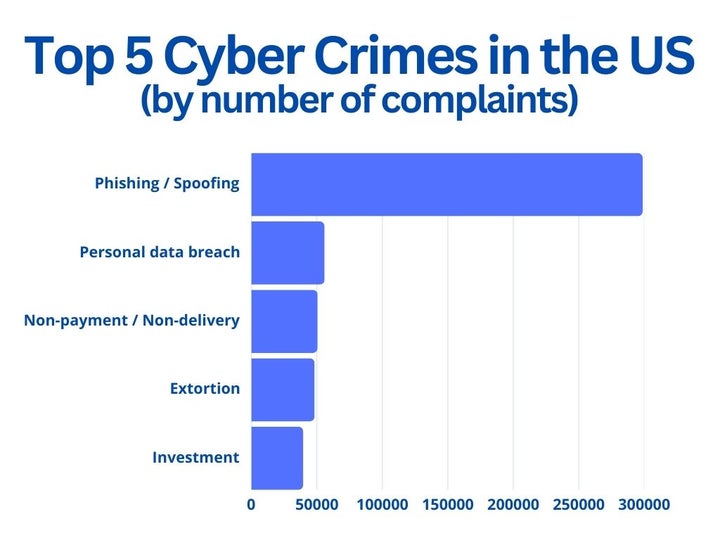
Here’s a list with the top 5 complaints recorded by the IC3 and the cyber crime linked to them:
- Phishing/Spoofing: 298,878 complaints.
- Personal data breach: 55,851 complaints.
- Non-payment, non-delivery: 50,523 complaints.
- Extortion: 48,223 complaints.
- Investment: 39.570 complaints.
If we look at the data breaches from the last 17 years and we compare the number of data compromises with the number of individuals impacted, we’ll notice how while there’s more data compromises YoY, the number impacted diminishes. According to the Identity Theft Resource Center, this is due to cybercriminals aiming to acquire personal information for identity theft instead of other types of attacks.
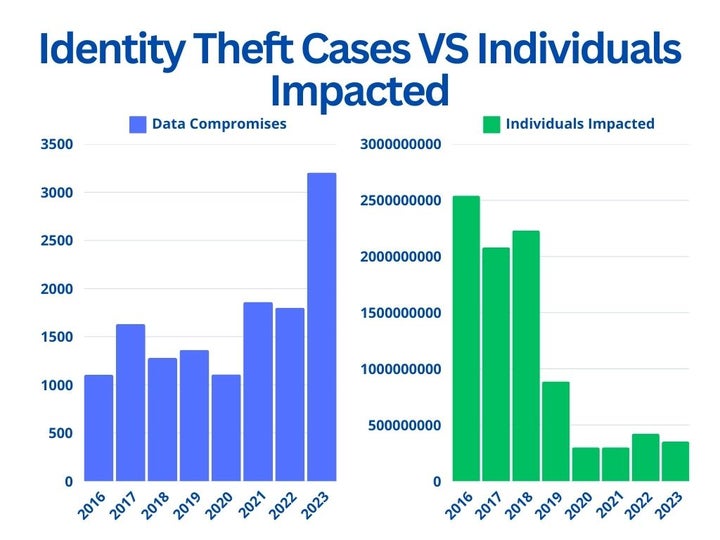
Here’s the breakdown of the results:
- 2016: Number of data compromises- 1,104 / Number of individuals impacted- 2,541,581,891
- 2017: Number of data compromises- 1,631/ Number of individuals impacted- 2,081,515,330
- 2018: Number of data compromises- 1,280 / Number of individuals impacted- 2,231,245,353
- 2019: Number of data compromises- 1,362 / Number of individuals impacted- 887,286,658
- 2020: Number of data compromises- 1,108/ Number of individuals impacted- 300,562,519
- 2021: Number of data compromises- 1,860 / Number of individuals impacted- 300,607,163
- 2022: Number of data compromises- 1,801 / Number of individuals impacted- 422,212,090
- 2023: Number of data compromises- 3,205 / Number of individuals impacted- 352,027,892
What is the Most Common Type of Identity Theft?
Out of the 841,810 cases of identity theft that were reported to the FTC, 38% of them were credit card fraud. In second position and taking 30% of the cases we find the impersonation of someone’s identity to create or access emails or social media accounts, as well as misusing someone’s shopping account. Finally in position 3 and with 15.5% of the cases we find using someone’s identity to be able to get some kind of loan or lease.
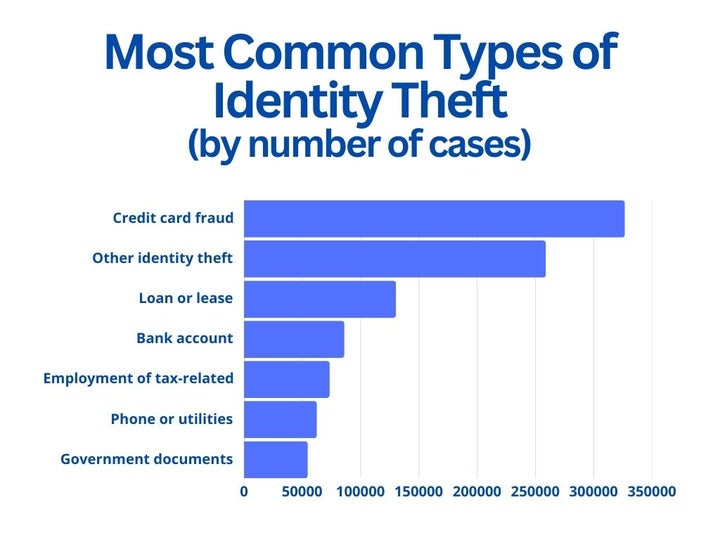
Here’s a complete breakdown of the results:
- Credit card fraud: 326,617 cases.
- Other identity theft: 258,843 cases.
- Loan or lease: 130,330 cases.
- Bank account: 86,035 cases.
- Employment or tax-related: 73,443 cases.
- Phone or utilities: 62,476 cases.
- Government documents of benefits: 54,678 cases.
(Source: FTC)
How High is Credit Card Fraud in the US?
Credit card fraud is the most common type of identity theft in the US. During the first 3 quarters of 2024, a total of 326,617 cases were reported in American grounds, being in pace with the cases reported in 2023.
If we look at the credit card fraud data from the last 5 years, we can see how there was a 43.91% increase in credit card fraud cases from 2019 to 2020. This surprising rise was the result of the COVID-19 pandemic, which boosted the number of cyber crimes around the world.
Also, it is important to point out how this rising trend hasn’t stopped even after the pandemic ended. In 2023 there were 53.37% more reported cases of credit card fraud than in 2019, reaching a similar number in 2024.
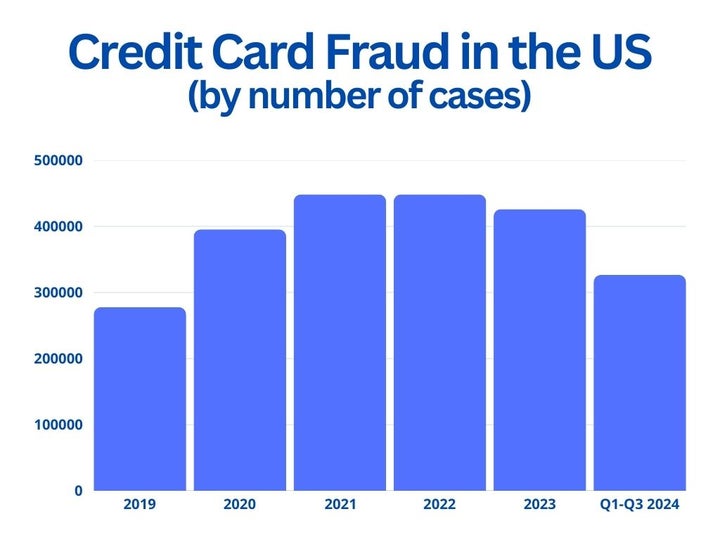
Here’s a detailed breakdown of the results:
- 2019: 277,739 cases.
- 2020: 399,721 cases.
- 2021: 395,391 cases.
- 2022: 448,459 cases.
- 2023: 425,977 cases.
- Q1-Q3 2024: 326,617 cases.
What Age Group is More Vulnerable to Identity Theft?
Victims of identity theft are more likely to be aged from 30 to 39 years old, closely followed by those who are 60-69. On the other end of the scale we have those who are 19 or under, being the least likely age group to fall victim to identity theft.
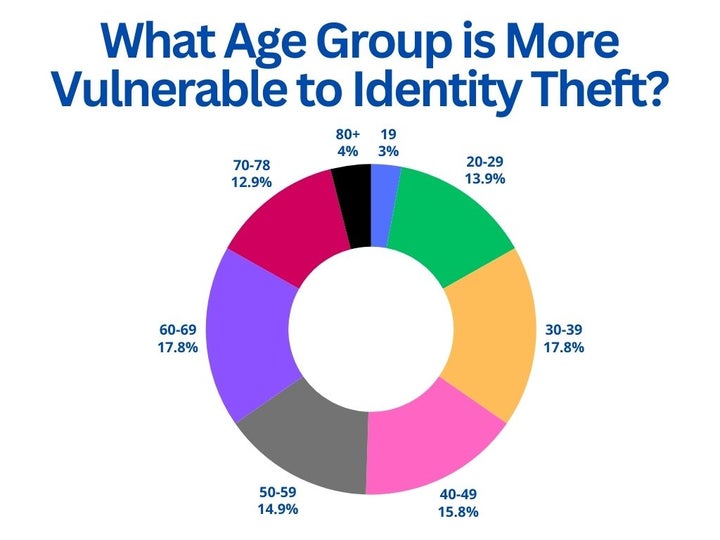
Here’s the full breakdown of the number of identity theft complaints reported in 2023 by the FTC, divided by age group:
- 19 and under: 28,965% (3%)
- 20-29: 157,908 (14%)
- 30-39: 201,519 (18%)
- 40-49: 175,402 (16%)
- 50-59: 168,166 (15%)
- 60-69: 199,453 (18%)
- 70-78: 144,461 (13%)
- 80 and over: 48,478 (4%)
How Much Money do People Lose From Identity Theft?
Only in 2023, the IC3 estimated an average of $12,5 billion losses to identity theft. As an average, a victim of identity theft and fraud loses $500, although the numbers increase exponentially with the victim’s age. It is also important to point out how younger people are more prone to reporting money loss to fraud than older people.
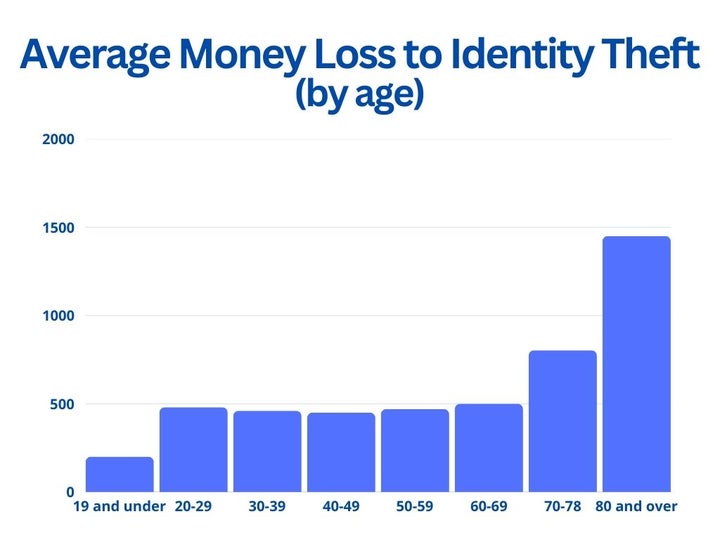
Here’s a detailed list with the average money lost to identity theft, divided by age groups:
- 19 and under: $200
- 20-29: $480
- 30-39: $460
- 40-49: $450
- 50-59: $470
- 60-69: $500
- 70-79: $803
- 80 and over: $1,450
(Source: FTC)
What Country Has the Most Identity Theft?
According to the latest data recorded by Statista, the country with the highest rate of identity theft is India, with a total of 27.2 million annual cases recorded. In second position we find the United States, with 13.5 million cases, closing the top three we have Japan with 3 million reports.

Here’s the complete list of results:
- India: 27.2 million cases.
- United States: 13.5 million cases.
- Japan: 3 million cases.
- Germany: 1.3 million cases.
- Australia: 0.85 million cases.
- France: 0.83 million cases.
- United Kingdom: 0.54 million cases.
- New Zealand: 0.23 million cases.
Wrapping Up
Identity theft is not going anywhere, with the latest data results still remaining significantly higher than pre-pandemic. With the rise of digitalization and AI, cyber criminals find new ways to get hold of personal data, with credit card and loan fraud increasing in the past few years.
One of the main culprits of the rise of identity theft were data breaches, which reached their peak in 2023. However the number of people they impacted were significantly lower than during previous years due cybercriminals changing their means to acquire personal information.
In conclusion, the best practices to safeguard our digital identity remain in using cybersecurity measures and always use common sense.
Mireia Fernández is passionate about the world of video games and new technologies, a hobby that dates back to her childhood with the MSX HB 501p. Born and residing in Barcelona, Mireia has been working as an editor for over 10 years and specializes in writing reviews, tutorials, and software guides, as well as doing everything possible to publish news before anyone else. Her hobbies include spending hours playing on her console, walking her golden retriever, and keeping up with the latest SEO developments.
Latest from Mireia Fernández
You may also like

Stranger Things tackles its final season ready to open new mysteries
Read more

Don't have plans for the weekend? Well, you have one of the greatest war movies in history available for streaming.
Read more

If you don't have Alan Wake Remastered, you can now get it for free
Read more

A legendary racing game from Nintendo 64 is coming to Nintendo Switch
Read more

The Summer Game Fest already has a date for its 2025 edition
Read more

Netflix lets us watch the opening of its Devil May Cry series and it's incredible
Read more